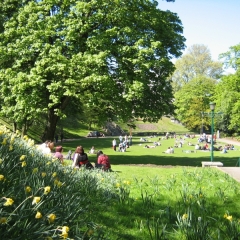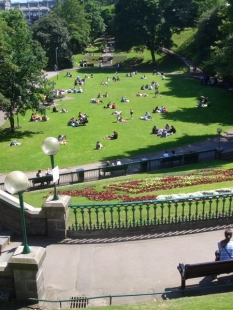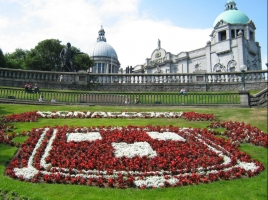Voice’s Old Susannah takes a look over the past week’s events in the ‘Deen and beyond. By Suzanne Kelly.
It’s been a very busy week in Aberdeen and the wider world. Donald Trump had a full page ad in the Press & Journal mixing wind farms and the Lockerbie bomber.
Of all the ways Trump could have used his revelation that Salmond wanted The Donald to back the releasing of the convicted Lockerbie Bombing, no one could have predicted such a crass, unsuitable, insensitive ad as this – unless they worked for Trump.
Funnily enough, the Press & Journal which carried this ad refused to carry an ad opposing the City Gardens Project, or so I’m told.
This refusal was interesting, as Aberdeen Journals did manage to carry a pro-web advertisement (the so-called ‘Holiday Inn’ ad, featuring the Holiday Inn logo, yet the ad was placed without the blessing of the Holiday Inn head office, as my enquiries determined). Trump couldn’t have put in his objectionable full-page ad if the P&J had not accepted it.
Rumours fly that Trump’s right hand woman Sarah Malone may have some romantic interest with a P&J supremo. Surely not! While all this carry-on was being carried out, one Mr Bates of the P&J was praising his organ for its unflagging support of the views of ‘the little man‘.
As long as the little man in question is a billionaire, then I guess that’s true.
There are several things I was tempted to satirise this week, not least of all the environmentally catastrophic notion of extending the industrial harbour into Nigg Bay. Thankfully the Marine Protection Act is coming into force soon; this should stop such a destructive plan.
I also doubt the people of Torry will want to surrender their last remaining stretch of coastline in exchange for yet more heavy good vehicles on Torry’s streets.
Some coastal land was sold years ago, allegedly to help the council with its finances. In return, the people of Torry were going to get … toilets. This toilet scheme was seemingly flushed down the pan by the Harbour Board (which now wants more Torry property). Kate Dean was also instrumental in putting a sewage plant next to Nigg Bay; the air and water pollution aspects are well known to area residents.
The impact of more trucks and more industry in this part of the city will be bad for health, and what remaining wildlife, sea, land and air we have left. We have a bird population which is down 50% in a decade according to the latest surveys – and we’re talking about birds not found in other parts of the world.
But money and empire-building seem set to win the day again. It seems that like Menie, the SSSI at Nigg Bay has very little importance to those in power if there is money about.
However, I can’t think of much aside from guns at the moment.
I don’t feel like making any jokes or satirical remarks. It’s time for another look at what guns have done to the US, and what we can do about air rifles and BB guns here – and why we definitely need to license air-guns in Scotland at the least.
The Michael Moore documentary film Bowling for Columbine came out 10 years ago. It is a brilliant assault on those who worship assault rifles. Sadly, the NRA – National Rifle Association – is about the most powerful lobbying force in Washington, and they will not let the US tighten up gun legislation. President Obama may now have something to say about that, as this latest tragedy is causing considerable public anger.
If you didn’t know, yet another damaged soul has been able to get their hands on automatic weaponry, and has murdered in cold blood 20 children and 6 women in the US state of Connecticut. If he hadn’t been able to easily obtain automatic weapons, these children and women would still be here. That is the fact.
Some people would tell you the American Constitution clearly states people should be able to have guns. It actually says this in its second amendment:
“A well-regulated Militia, being necessary to the security of a free State, the right of the people to keep and bear Arms, shall not be infringed.”
Where do we start on this? Firstly, this was written 200 years ago – people had muskets and similar types of guns. These were not as accurate as today’s guns, and they certainly were not automatic. A lone shooter would not have been able to take out 26 people in a short span of time.
Secondly, times have changed just a little bit. The Constitution and its Amendments were written following a war of independence, in which the British sought to control the revolutionaries’ weapons. It’s no longer relevant, just as passages in the Old Testament are no longer relevant (except to the odd fanatic).
At this point many people would point out, correctly, that American and British weaponry is being used all over the world. Make no mistake, I hate that as well. The exportation of weapons to corrupt and violent regimes is unacceptable of course. But that is a different story. This is about a nation gone mad, a nation which won’t allow Cuban cigars or unpasteurised milk products.
there are counties where it is mandatory everyone carries a gun once they’re a certain age
This is about a re-imagining of the Second Amendment to the Constitution, while at the same time the main thrust of the revolution was to guarantee that all men (and women) are created equal, and shall not be deprived unreasonably of the rights to life, liberty and the pursuit of happiness. Yet these rights have been trampled into the dust.
People are not free in most states to marry as they choose. People are in some places not free to teach evolutionary theory, and creationism is given pride of place in science classes. And of course, the evil, horrible plant that is marijuana is totally illegal in most places – a bit of a blow (if you will) to ‘the pursuit of happiness’ for a small minority of people who’d like to use it for recreation, pain control, nausea control, glaucoma treatment and so on.
But while the US forgets or re-writes the basics, the NRA is free to insist that the Second Amendment means everyone everywhere is entitled to have a gun. In fact, there are counties where it is mandatory everyone carries a gun once they’re a certain age.
We recently saw the reports of a girl shot by her cousin on Halloween. She’d been dressed up in black and white, and the cousin apparently thought she was a skunk.
It wasn’t the first time or the last time someone trying to ‘defend their home’ with a gun shoots relatives instead. Teens that’ve snuck home late at night have been shot dead by paranoid parents assuming burglars were about. People have also had their own weapons used against them.
The inimitable Morgan Freeman has also weighed into the debate, reminding us that the media has to take a new look at how it reports these mass killers. The killer gets tons of news coverage, and sees their picture, life and crime scene spread across TV, internet, print and radio. An old and easily disproved adage goes ‘there is no bad publicity’.
To some of these people, like the gunman in Colorado who shot movie-goers, fame indeed seems to play some twisted part in their murders. Let’s not give them any publicity by name; let’s remember instead the victims.
Yes, such a move would cost money – the US could take this from its massive defence budget
America also seems to have a twisted love affair with imagery of girls in bikinis firing automatic weapons. This is adding sex appeal to weaponry designed to take out lots of life quickly. No one needs to prove they are a good shot if they have an AK-47 – you just shoot until you obliterate the target. Anyone but me see anything wrong with this picture?
What’s the answer? I’ve no idea. But would it be so bad to start with a gun amnesty?
These have been done in New York in the past, twenty years ago in fact, by New York entrepreneur Fernando Mateo. This was an admirable move. If so much as one life was saved by this initiative, it was worth doing. With the number of illegal guns handed in at the time, it is easy to conclude that many lives were saved. Couple a gun amnesty with mandatory licensing, yearly license renewals and yearly gun checks, and you could save a few more lives.
Yes, such a move would cost money – the US could take this from its massive defence budget. They’re still not able to adequately feed and clothe all of its citizens, but according to the Huffington Post and other sources, it spent some $695 BILLION on defence in 2011. It’s hard to see how present and especially future generations are going to forgive the world’s military for all of its spending on military hardware.
So – gun amnesty, tighten up licensing, make it more difficult to get and keep guns, and finally increase penalties for anyone with illegal guns, and anyone who commits a crime with a gun. Would it solve the problem?
The NRA are masters of spin and lobbying; their famous slogans include:
“Guns don’t kill people, people kill people,” and
“If guns were outlawed, only outlaws would have guns.”
Students of propaganda will recognise these kinds of reflexive slogans are catchy. Catchy they are, but do they stand up to any scrutiny? Of course not.
To the former slogan, obviously, (sadly) people can kill each other in many ways. But having a gun makes it a much simpler, surer and simpler matter. Having an automatic weapon makes it certain you can kill lots of people, quickly, and from a distance. I’d prefer ‘guns make it easy for people to kill people, and the NRA makes it easy to get guns’ as a replacement slogan. Not as catchy, but it is considerably more accurate.
To the second phrase – this is an attempt, also a tried and tested propaganda method, to instil fear. ‘If I don’t have a gun, an outlaw can get me!’ is the underlying message. Here are a few words from The Survivors’ Club which should make people think twice:
“In 2008 there were 680 accidental shooting deaths in the United States, with more than 15,500 shooting injuries. Most disturbing, perhaps, is the number of children involved in accidental shootings. Every day approximately five children are injured or killed on a nationwide basis as a result of handguns. The primary cause of youth-involved shooting rests with the fact that children find loaded handguns in the home – and natural curiosity leads them down the road to disaster.
“Each year approximately 100 people are injured or killed while cleaning a firearm and failing to exercise proper caution… Many accidental shootings occur because someone believes a gun is unloaded, points it at someone and pulls the trigger as a “joke”.”
See: http://www.thesurvivorsclub.org/extreme/surviving-accidents/accidental-shooting
Japan has managed to outlaw guns totally – and now has c. 2 gun deaths per year. Isn’t that an accomplishment to at least try to emulate?
See: http://www.theatlantic.com-how-japan-has-virtually-eliminated-shooting-deaths
By all means have an armed and well-regulated militia (but hopefully one that needn’t cost over 600 billion dollars a year). These killers clearly are not well-regulated, and they are not in a militia. It’s time to think again.
It’s also time for me to move closer to home, for we have some air gun issues to deal with. If you live in the area, you will know that some people have been targeting animals for some time with air guns, blinding and wounding pets. Most lately, we have a field of horses in the Bridge of Don area being used for target practice so that idiots can get their kicks from wounding innocent horses.
Do I think things will get worse? Yes. Why do I think that? Because a newish discount/pound shop is selling BB-type guns for £6, and lots of ammo. Did I ask them to please not stock these items? Yes. They refused, saying they only sell to those over 18. Do we know any people over 18 who are less than mature? I do. Please feel free to share your thoughts with the manager; this shop is a few doors down from Molton Brown.
We now have a chance to regulate these kinds of weapons in Scotland. There is no way responsible owners of such guns can logically oppose tighter registration in the face of the violence against animals and people that has taken place.
You might recall a toddler was killed by such a weapon in Glasgow, one of the main reasons this legislation is coming about. We’re not talking about something that causes a small discomfort, we’re talking about speeding projectiles that destroy tissue and can even damage bone.
Here are a few words from Animal Concern Advice Line:
”Proposals for Licensing Air Weapons in Scotland
“[there is a] very important consultation which could be used to greatly reduce the number of air weapons in Scotland. As you know air-guns are the tools of vandals and sadists who take pot shots at pet, farm and wild animals and birds.
If you have had personal experience of air-gun misuse or if you run an animal sanctuary and have had to deal with animals shot by people using air-guns please mention that in your submission… If you have a pet why not forward this message to your vet? Most vets know just how much pain, suffering and death is caused by air weapons.”
“The pro-gun lobby will be doing all they can to reduce the impact of this initiative. Please take the time to comment – it will make a difference.”
Clearly not all air-gun owners are sadists – but since we have quite a few who are clearly are, then let’s get some control in place.
Please visit http://suzannekelly.yolasite.com/ to see how you can help and to read the Government’s document
Merry Christmas; Happy Holidays; Happy Chanukah – can everyone please stop shooting now?
Next week – a return to normal service.
- Comments enabled – see comments box below. Note, all comments will be moderated.












